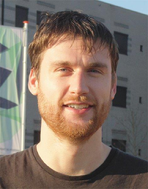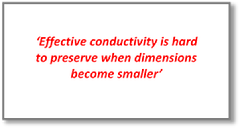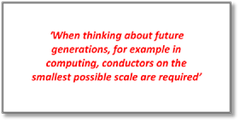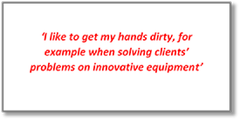 When length scales diminish more and more, single electron behaviour is subjected to complicated quantum effects. In this thesis the conductance of systems is studied containing Au (gold), Ir (iridium) and Pt (platinum) wires, the middle one being the favourite of author René Heimbuch. ‘One of the key results of my work is that effective conductivity is hard to preserve when dimensions become smaller,’ he says. ‘Iridium has this very nice feature: when building bottom-up on Ge (001) surfaces, stable double-row wires form, enabling electrons to travel in the interspace between the two walls.’
When length scales diminish more and more, single electron behaviour is subjected to complicated quantum effects. In this thesis the conductance of systems is studied containing Au (gold), Ir (iridium) and Pt (platinum) wires, the middle one being the favourite of author René Heimbuch. ‘One of the key results of my work is that effective conductivity is hard to preserve when dimensions become smaller,’ he says. ‘Iridium has this very nice feature: when building bottom-up on Ge (001) surfaces, stable double-row wires form, enabling electrons to travel in the interspace between the two walls.’
Different materials wires show high differential conductivity in the chains. This catapults Ir/Ge(001) systems to a top of candidates for one-dimensional electronic systems, René Heimbuch concludes in his thesis work.

‘When thinking about future generations, for example in computing, conductors on the smallest possible scale are required,’ he states. ‘Other metal/Ge (001) systems require far more complex 1D nanostructures.’
Surprising effects occur when studying conductance properties at single atom levels, Heimbuch found out. At low temperatures, Pt wires will turn into insulators even, creating electronic walls. Electrons are travelling between these isolating walls. ‘A single chain will do nothing,’ he says. ‘This feature clearly states conductivity is limited when nano scales are reached.’
Molecular manipulation
Heimbuch, together with colleagues from the Physics of Interphases and Materials Group, won the poster award at the annual Mesa+ Day event. In order to achieve control over the tip/surface contact - during Scanning Tunneling Microscope measurements (and manipulations) on wire systems - an octanethiol molecule was attached to this very STM tip. ‘We were able to switch the conductance state of a single molecular junction, by varying the contacts’ interspace or by applying voltages,’ he says.

His experimental skills were recognized by the Quantum Transport in Matter Group, led by Professor Alexander Brinkman. ‘My expertise proved useful for studies on electronic states in topological insulators,’ he says. ‘We started a fruitful collaboration, leading to a nice publication along the way.
‘Alexander Brinkman knew our expertise on handling the STM machine. We sat down, talked about still unanswered questions of these structures, and how I could help to answer them with the STM. Also I collaborated with the MTP, Materials Science and Technology of Polymers Group. The easy excess to adjacent expertise is a vast surplus of an Institute such as Mesa+. Colleagues are approachable and willing to share expertise.’
Hands-on

René is keen to go and work in industry rather than continuing his academic career. ‘I had my fun here,’ he says. ‘Fact is: I like to get my hands dirty. For example while working as a technology consultant, solving clients’ problems on using innovative equipment.
‘I wouldn’t mind to work in a small or middle sized enterprise company. My hands-on skills will prove useful, I am sure, as will be my capability of solving problems, working resourceful. I learned to be creative, and always think outside of the box.’
